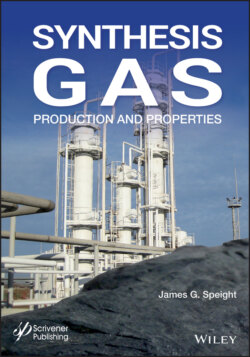Читать книгу Synthesis Gas - James Speight G., James G. Speight - Страница 39
2.3.8 Mixed Feedstocks
ОглавлениеAny carbonaceous feedstock may be co-gasified with waste or biomass for environmental, technical or commercial reasons (Chapter 5, Chapter 6, Chapter 7). It allows larger, more efficient plants than those sized for grown biomass or arising waste within a reasonable transport distance; specific operating costs are likely to be lower and fuel supply security is assured.
Although the gasification processes used for individual feedstocks are relatively straightforward, process efficiency depends for the most part on the unique characteristics of each feedstock. In addition, the non-uniformity of the feedstocks and the variability of the specific compositions over time require flexible and robust gasifiers. For example, consideration should be given to the individual constituents of each feedstock to determine if there are any reactions between the constituents that can have an adverse effect on the process. An example is the composition of any mineral matter that may cause the constituents to interact to form a troublesome slag that may cause harm to the gasifier.
However caution is advised when using mixed feedstocks for gasification or, for that matter, for any conversion process. It has been the method in the past (and even continued to be the method in some cases) to assess the properties of the mixed feedstock by calculating an average value for one or more of the properties of the mixed feedstock. This is a dangerous practice because it ignores the potential for interaction of the contents of each feedstock that can cause changes in the chemistry of the process as well as a loss of process efficiency.
One approach to avoid a significant decrease in conversion efficiency is to develop a formulation of mixed feedstocks in order to produce a more consistent material. Formulation combines various preprocessed resources and/or additives to produce a feedstock that provides process consistency.
Feedstock formulation is not a new concept and has been used for decades by the coal industry. For example, different grades of coal are blended for power generation to reduce the sulfur content and the nitrogen content of the feedstock. In the current context, biomass blending feedstocks refers to the combination of multiple sources of the same biomass resource to average out compositional and moisture variations, whereas aggregation refers to the combination of different raw or preprocessed biomass resources to produce a single, consistent feedstock with desirable properties. Examples include mixing blended corn stover with blended switchgrass; mixing blended wheat straw with blended softwood residuals; and mixing blended Miscanthus with blended rice hulls. This strategy allows the desirable characteristics of many types of feedstocks to be combined to achieve a better feedstock than any of the feedstocks alone (Shi et al., 2013; Lu and Berge, 2014).
Examples to emphasize the above considerations are presented below and relate to (i) the gasification of biomass and coal, (ii) the gasification of biomass and municipal solid waste.
